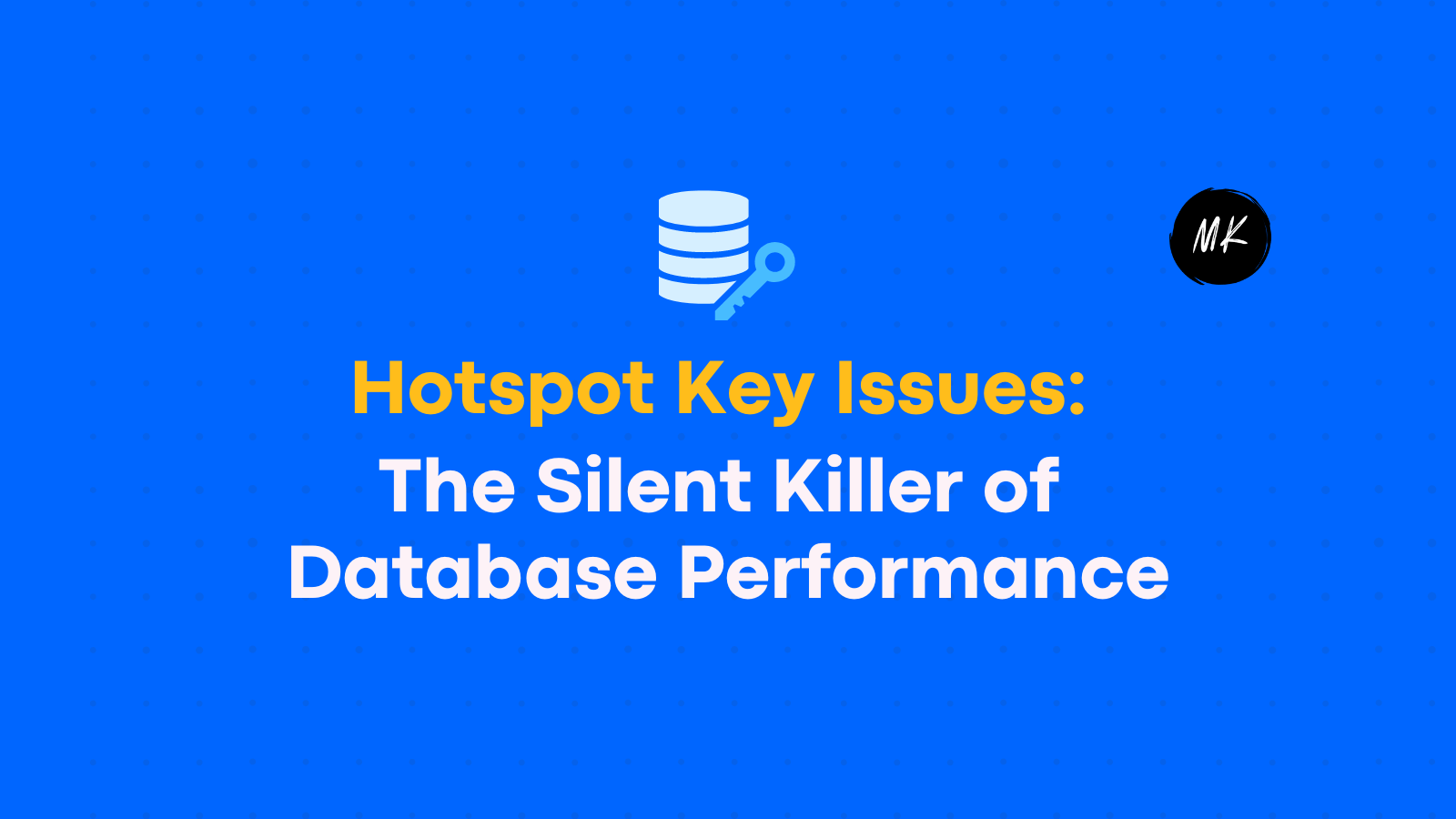Hotspot Key Issues: The Silent Killer of Database Performance

What is Hotspot Key problem in Database?
Databases are essential for storing and quickly retrieving data for users. When databases receive a large volume of unprecedented traffic, some keys in the database can become "Hotspot" and cause performance degradation. This is a known issue in databases and is referred to as the "Hotspot Key" problem.
A Hotspot key refers to a single key in the database that experiences an extremely high volume of read and write operations. This sudden increase in traffic can cause the database to slow down, resulting in increased latency, higher response times, and in some cases, even downtime.
Examples of Hotspot Key Issues
To understand the impact of Hotspot keys, let's take a look at a few real-world examples.
- Social Media: Consider a social media platform where users can upload and share their posts. If a single user's post becomes extremely popular and receives a high volume of likes and comments, the database key responsible for storing that post can become a Hotspot key. As a result, the database may slow down and cause increased latency for other users trying to access the platform.
- E-Commerce: An e-commerce platform that experiences a surge in traffic during a flash sale can also be affected by Hotspot keys. If a large number of users are trying to purchase the same product at the same time, the database key responsible for storing the inventory information can become a Hotspot key. This can result in decreased performance, increased latency, and even downtime.
Performance and Downtime Issues due to Hotspots
When Hotspot keys occur, the database can experience a range of performance and downtime issues, including:
- Increased Latency: The database may take longer to respond to user requests, leading to increased latency and decreased user experience.
- Higher Response Times: As the database becomes congested, response times can increase significantly, leading to a slower user experience.
- Downtime: In severe cases, the database may become unavailable due to the high volume of traffic, leading to downtime.
- Data Loss: If the database becomes unavailable, there is a risk of data loss, which can have significant consequences for both the user and the application.
How to Resolve Hotspot Key Issues in Redis
Redis is an open-source, in-memory data structure store that is often used as a database. It is a popular choice for many applications due to its high performance and scalability.
However, Redis is not immune to Hotspot key issues, and it is essential to address them promptly to avoid performance degradation.
The following are some of the ways to resolve Hotspot key issues in Redis:
- Redis Cluster: It is a distributed solution that allows Redis to scale horizontally. This means that the load can be distributed across multiple nodes, reducing the risk of Hotspot keys.
- Redis Sentinel: It is a high-availability solution that monitors Redis instances and provides automatic failover in the event of a failure. This can help to reduce downtime and improve the availability of the database.
- Sharding: It is a technique that involves splitting the data across multiple Redis instances. This can help to distribute the load and reduce the risk of Hotspot keys.
How to Resolve Hotspot Key Issues in DynamoDB
DynamoDB is a fully managed, NoSQL database service provided by Amazon Web Services (AWS). It is a highly scalable and reliable database that is well suited to handling large volumes of data.
However, Hotspot key issues can still occur, and it is important to resolve them promptly to avoid performance degradation.
The following are some of the ways to resolve Hotspot key issues in DynamoDB:
- Partitioning: DynamoDB uses partitioning to distribute data across multiple nodes. By properly partitioning the data, the risk of Hotspot keys can be reduced.
- Provisioned Throughput: DynamoDB allows you to specify the amount of read and write throughput that you need. By provisioning the correct amount of throughput, you can avoid Hotspot keys and ensure that the database performs optimally.
- Auto Scaling: DynamoDB supports auto-scaling, which means that the database will automatically increase or decrease the capacity based on the traffic. This can help to ensure that the database is always operating at the optimal level and reduces the risk of Hotspot keys.
How to Resolve Hotspot Key Issues in MySQL / PostgreSQL
Hotspot key issues can also occur in relational databases like MySQL and PostgreSQL. The following are some of the ways to resolve Hotspot key issues in these databases:
- Partitioning: It the data in relational databases can help to distribute the load and reduce the risk of Hotspot keys. There are several methods for partitioning data in relational databases, including range partitioning, hash partitioning, and list partitioning.
- Indexing: It can help to optimize the performance of queries and reduce the risk of Hotspot keys. By creating the right indexes, you can ensure that queries are optimized and that the database performs optimally.
- Sharding: It is a technique for distributing data across multiple nodes in a database. By properly sharding the data, the risk of Hotspot keys can be reduced and the database can be optimized for performance.
- Load Balancing: It can help to distribute the load across multiple nodes in a database. By properly configuring the load balancing, you can reduce the risk of Hotspot keys and ensure that the database performs optimally.
- Query Optimization: It can help to reduce the risk of Hotspot keys by improving the efficiency of queries. This can be achieved by using indexes, partitioning, and sharding, as well as by optimizing the structure of the queries themselves.
System Design strategies to prevent Hotspot issues
Designing your system with Hotspot issues in mind can help to prevent them from occurring in the first place. Here are some System design strategies to prevent Hotspot issues:
- Data distribution: It is important to properly distribute your data across multiple nodes or partitions to reduce the risk of Hotspot keys. This can be achieved through techniques such as sharding or partitioning.
- Read/write patterns: Understanding the read/write patterns of your application can help you to identify Hotspot keys and design your system to avoid them. For example, if you have a high volume of writes to a particular key, you may want to consider partitioning that key to avoid Hotspots.
- Data modeling: Proper data modeling can help to reduce the risk of Hotspot keys by ensuring that your data is structured in a way that is optimized for performance. For example, by denormalizing your data, you can reduce the number of joins required and improve performance.
By following these best practices, you can optimize your system design to prevent Hotspot issues and ensure that your database is always operating at peak performance.
A few Overkill optimizations to avoid
When it comes to resolving Hotspot key issues, it is important to understand that some optimizations can actually make the situation worse.
The following are some optimizations to avoid:
- Caching: It can help to reduce the load on the database, but it can also cause Hotspot keys if the cache becomes congested.
- Denormalization: It can help to reduce the number of database queries, but it can also result in data inconsistencies and increase the risk of Hotspot keys.
- Over-provisioning: It can help to ensure that the database has enough capacity, but it can also result in increased costs and reduced efficiency.
Conclusion: Why Avoiding Hotspot Key Issues is Important
In conclusion, Hotspot key issues are a real problem that can silently kill the performance and degrade the availability of databases. It is important to understand the causes of Hotspot keys and to resolve them promptly to avoid performance degradation.
By using the right tools and techniques, it is possible to reduce the risk of Hotspot keys and ensure that your database is always operating optimally.
By avoiding Hotspot key issues, you can ensure that your users have a positive experience, that your data is always available and secure, and that your application is scalable and reliable. This can help to build a loyal user base and establish a positive reputation for your business.
